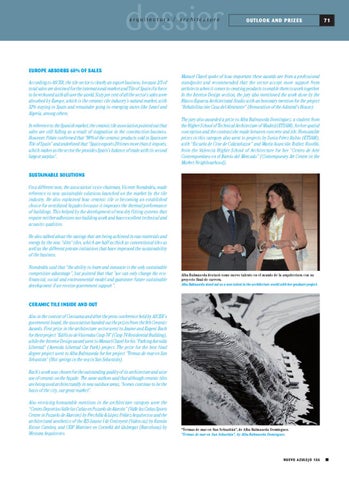dossier arquitectura / architecture
O UTLO O K AN D P R I Z E S
EUROPE ABSORBS 60% OF SALES According to ASCER, the tile sector is clearly an export business, because 2/3 of total sales are destined for the international market and Tile of Spain if a force to be reckoned with all over the world. Sixty per cent of all the sector's sales were absorbed by Europe, which is the ceramic tile industry's natural market, with 32% staying in Spain and remainder going to emerging states like Israel and Algeria, among others. In reference to the Spanish market, the ceramic tile association pointed out that sales are still falling as a result of stagnation in the construction business. However, Piñón confirmed that "90% of the ceramic products sold in Spain are Tile of Spain" and underlined that "Spain exports 20 times more than it imports, which makes us the sector the provides Spain's balance of trade with its second largest surplus".
Manuel Clavel spoke of how important these awards are from a professional standpoint and recommended that the sector accept more support from architects when it comes to creating products to enable them to work together. In the Interior Design section, the jury also mentioned the work done by the Blasco Esparza Architectural Studio with an honorary mention for the project "Rehabilitación Casa del Almirante” (Renovation of the Admiral's House). The jury also awarded a prize to Alba Balmaseda Domínguez, a student from the Higher School of Technical Architecture of Madrid (ETSAM), for her spatial conception and the contrast she made between concrete and tile. Honourable prizes in this category also went to projects by Sonia Pérez Rubio (ETSAM), with “Escuela de Cine de Calatañazor” and María Asunción Ibáñez Roselló, from the Valencia Higher School of Architecture for her “Centro de Arte Contemporáneo en el Barrio del Mercado” (Contemporary Art Centre in the Market Neighbourhood).
SUSTAINABLE SOLUTIONS On a different note, the association's vice chairman, Vicente Nomdedéu, made reference to new sustainable solutions launched on the market by the tile industry. He also explained how ceramic tile is becoming an established choice for ventilated façades because it improves the thermal performance of buildings. This helped by the development of new dry fitting systems that require neither adhesives nor building work and have excellent technical and acoustic qualities. He also talked about the savings that are being achieved in raw materials and energy by the new "slim" tiles, which are half as thick as conventional tiles as well as the different private initiatives that have improved the sustainability of the business. Nomdedéu said that "the ability to learn and innovate is the only sustainable competitive advantage”, but pointed that that "we can only change the ecofinancial, social and environmental model and guarantee future sustainable development if we receive government support ".
Alba Balmaseda destacó como nuevo talento en el mundo de la arquitectura con su proyecto final de carrera. Alba Balmaseda stood out as a new talent in the architecture world with her graduate project.
CERAMIC TILE INSIDE AND OUT Also in the context of Cevisama and after the press conference held by ASCER's government board, the association handed out the prizes from the 9th Ceramic Awards. First prize in the architecture sector went to Jaume and Eugeni Bach for their project "Edificio de Viviendas Casp 74" (Casp 74 Residential Building), while the Interior Design award went to Manuel Clavel for his "Parking Avenida Libertad" (Avenida Libertad Car Park) project. The prize for the best final degree project went to Alba Balmaseda for her project "Termas de mar en San Sebastián" (Hot springs in the sea in San Sebastián). Bach's work was chosen for the outstanding quality of its architecture and wise use of ceramic on the façade. The same authors said that although ceramic tiles are being used architecturally in new outdoor areas, "homes continue to be the basis of the city, our great market". Also receiving honourable mentions in the architecture category were the “Centro Deportivo Valle las Cañas en Pozuelo de Alarcón” (Valle las Cañas Sports Centre in Pozuelo de Alarcón) by Frechilla & López-Peláez Arquitectos and the architectural aesthetics of the IES Jaume I de Ontinyent (Valencia) by Ramón Esteve Cambra, and CEIP Martinet en Cornellà del Llobregat (Barcelona) by Mestura Arquitectes.
“Termas de mar en San Sebastián”, de Alba Balmaseda Domínguez. “Termas de mar en San Sebastián”, by Alba Balmaseda Domínguez.
N U EVO A Z U L E J O 156
71
